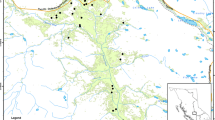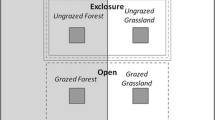Abstract
This paper reports on changes induced by the introduction of cattle in a grassland that had remained ungrazed for 9 yr, in comparison with two adjacent grasslands: one that remained enclosed and one that has been continuously subject to grazing. Basal cover was measured on 25 interception lines, each 1 m long, three times during one year. The variables studied were: total cover, cover of grasses and dicots, cover of creeping grasses, floristic composition, and dissimilarity among sites. At the first sampling, 2 yr after cattle re-introduction, the newly grazed site was more similar to the ungrazed than to the grazed site. The newly grazed site had very low cover of dicots; the species of dicots present were different from those found in the continuously grazed area. Creeping grasses had higher cover in the newly grazed site than in the other sites, and continued to increase. At the last sampling, one year later, the newly grazed site had become more similar to the contiuously grazed site. Only after 5 yr of cattle grazing the exotic dicots that were dominant in the continuously grazed site, were recorded in the re-opened site. The absence of propagules of these species or the absence of safe sites may account for this delayed invasion.
Similar content being viewed by others
References
Bakker, J. P. 1985. The impact of grazing on plant communities, plant populations and soil conditions in salt marshes. Vegetatio 62: 391–398.
Brown, D. 1954. Methods for surveying and measuring vegetation. Commonwealth Agricultural Bureau. Bucks, England.
D'Angela, E., Facelli, J. M. & Jacobo, E. 1988. The role of the soil seed bank on the early stages of a post agricultural succession in the Inland Pampa, Argentina. Vegetatio 74: 39–45.
Davis, M. B. 1986. Climatic instability, time lags and community disequilibrium. In: Diamond, J. & Case, T. J. (eds), community ecology. Harper & Row, New York.
Deregibus, V. A., Sánchez, R. A., Casal, J. J. & Trlica, M. J. 1985. Tillering responses to enrichment of red light beneath the canopy in humid natural grasslands. J. Appl. Ecol. 22: 199–206.
Facelli, J. M., León, R. J. C. & Deregibus, V. A. (in press). Community structure in grazed and ungrazed grasslands of the Flooding Pampa, Argentina. Am. Midl. Nat.
Gorham, E. 1957. Development of peatlands. Quart. Rev. Biol. 32: 145–166.
Hulbert, S. H. 1984. Pseudoreplication and the design of ecological field experiments. Ecol. Mongr. 54: 187–211.
Knapp, A. K. & Seastedt, T. R. 1986. Detritus accumulation limits productivity of tall-grass prairie. BioScience 36: 662–668.
Lavado, R. S. & Taboada, M. A. 1987. Soil salinization as an effect of grazing in a native grassland soil in the Flooding Pampa of Argentina. Soil Use Manage. 3: 143–148.
León, R. J. C. 1975. Las comunidades herbáceas de la Región Castelli-Pila. Monografias CIC No. 5. La Plata (Argentina) 147 pp.
Mack, R. M. & Thompson, J. N. 1982. Evolution in steppes with few large, hoofed mammals. Am. Nat. 119: 757–773.
Numata, M. 1980. Experimental studies on the early stages of secondary succession. Vegetatio 48: 141–149.
Paneta, F. D. 1984. Population studies in pennyroyal mint (Mentha pulegium) II. Seed banks. Weed Res. 25: 311–315.
Pickett, S. T. A., Collins, S. L. & Armesto, J. J. 1987. A hierarchical consideration of causes and mechanisms of succession. Vegetatio 69: 109–114.
Poole, R. 1980. An introduction to quantitative ecology. McGraw & Hill, Tokyo.
Roberts, H. A. 1986. Seed persistence in the soil and seasonal emergence in plant species from different habitats. J. Appl. Ecol. 23: 639–656.
Sala, O. E., Oesterheld, M., León, R. J. C. & Soriano, A. 1986. Grazing effect on plant community structure in a subhumid grassland of Argentina. Vegetatio 67: 27–32.
Soriano, A. (in press). Natural grasslands of South America. In: Coupland, R. (ed.), Temperate subhumid grasslands. Elsevier, Amsterdam.
Summerfield, R. J. 1972. Biological inertia. An example. J. Ecol. 60: 793–798.
Taboada, M. A. & Lavado, R. S. (in press). Grazing effects on soil bulk density in the Flooding Pampa of Argentina. J. Range Manage.
Tilman, D. 1985. The resource ratio hypothesis of plant succession. Am. Nat. 125: 827–852.
VanDorp, D., Boot, R. & van derMaarel, E. 1985. Vegetation succession on the dunes near Oostvoorne, The Netherlands, since 1934, interpreted from air photographs and vegetation maps. Vegetatio 58: 123–136.
Author information
Authors and Affiliations
Rights and permissions
About this article
Cite this article
Facelli, J.M. Response to grazing after nine years of cattle exlusion in a Flooding Pampa grassland, Argentina. Vegetatio 78, 21–25 (1988). https://doi.org/10.1007/BF00045635
Accepted:
Issue Date:
DOI: https://doi.org/10.1007/BF00045635




